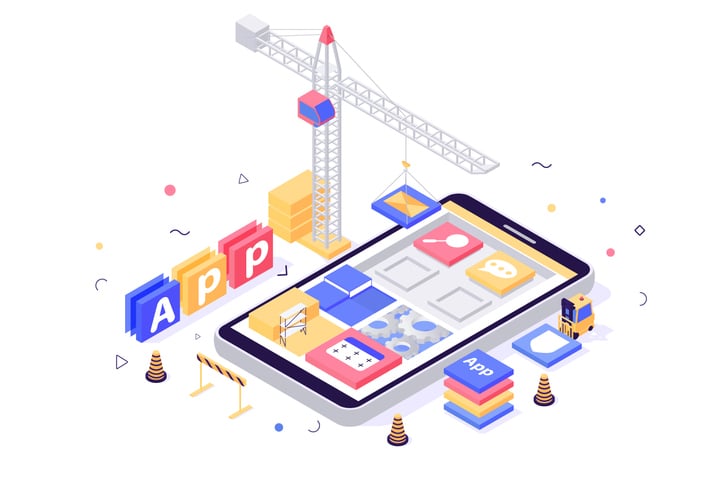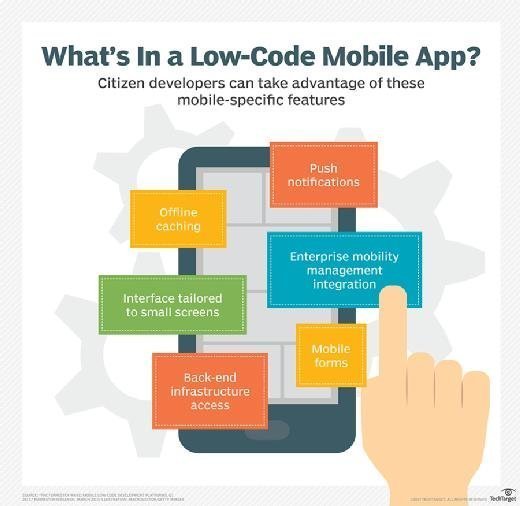Due to a range of important factors, Low-Code Application Development is available to non developers. They are also referred to as "citizen designers."
Drag-anddrop Builders: Lowcode platforms provide drag-and-drop interfaces, which allow nondevelopers to visually create applications without the need for code. Development is now more accessible for people with no technical background.
WYSIWYG: WYSIWYG editors are "What you see is what you Get" editors that allow users to create workflows and interfaces similar as the final product. It makes it much simpler to use and understand.
Simplified Workflow and Logic Design
Visual Workflow Modeling - Users can create business processes and logic applications by using visual flowcharts or models. This is a lot more efficient than traditional programming techniques.
Pre-built Logic Components: Low-code platforms typically contain pre-built logic components (e.g. statements that are conditional loops) which can be easily configured, reducing the need for complex coding.
Reusable components and templates:
Library of pre-built templates A lot of low-code platforms provide templates for common application types which allow non-developers to start with a solid foundation to customize as needed.
Reusable Modules and Widgets: Utilizing the reuse of modules and widgets users can speed up the creation process, while also reducing the requirements for technical expertise.
Guided Development and Tutorials
Step-by-Step guides: Platforms provide instructions and help on screen to non-developers who are building applications.
Interactive Tutorials Interactive tutorials are hands-on and interactive, which help users to learn by doing. This improves the confidence of users in the platform.
Integration with Existing Tool:
Seamless integration Low-code platforms are developed to integrate seamlessly with the existing business tools and systems (e.g. ERP, CRM) making it possible for non-developers to develop applications in their existing workflows.
APIs and Connectors : APIs built-in and connectors allow users and non-developers to connect their applications to external services, without the need for complicated coding.
Collaboration Features:
Team Collaboration: Features such as real-time collaboration workspaces and shared workspaces make it possible for non-developers to collaborate effectively with business analysts, developers and other users.
Access Control Based on Roles: Users who do not develop are able to have access to roles and levels of access that permit users to contribute, without compromising functionality or security.
Automated Testing & Debugging
Low-code platforms are often equipped with testing and debugging software that automatizes these procedures. This makes it easier for non developers to verify their applications function correctly.
Platform identifies errors as they happen and provides solutions. This aids non-developers with problems.
Development using low-code is easier for non-developers to access because it democratizes the development process. With its an intuitive, visually-guided tool and experiences, low code platforms allow business owners to actively participate and maintain applications. View the most popular Low-code Platform for application development url for website tips including push notifications, stored sql procedures, application development platforms, mobile app development platforms, application modernisation, rapid applications, build with docker, developing mobile apps, mobile app development platforms, develop web app and more.

Cost-Effectiveness Is One Of Many Advantages Of Developing Apps Using Low-Code.
The low-code method of application development is an affordable solution that has many benefits. It's a fantastic option for companies looking to maximize their budgets and deliver high-quality apps. Below are some of the main advantages.
Reduced Coding: Low-code platforms cut down on the amount of hand-coding required, which in turn helps developers save time and energy when building applications. This results in lower labor costs.
A smaller number of developers: Since low-code development is quicker and easier and less complex, there are fewer developers needed. This could drastically cut costs of staffing and hiring.
Faster time to market:
Accelerated Cycle of Development Visual tools for low-code platforms and components enable rapid development of applications, which lets businesses launch their new products quicker. This can lead to faster revenue generation and better competitive positioning.
Rapid Prototyping: Businesses are able to quickly create prototypes and then test them, which can cut down the time required in the development phase and allowing faster iterations that are based on feedback from the users.
Low Maintenance Costs
The modular architecture and standardized components of applications developed with low-code platforms make them easy to maintain. The ongoing maintenance and support costs are cut.
Automated Updates: Many low-code platforms can handle updates and patches automatically and ensure that applications are secure and up-to-date, without the need for lengthy manual intervention.
Efficient Resource Utilization:
Platform contributions that are low-code let businesses as well as others who are not developers to take part in the process of creating. This openness of the development process permits businesses to utilize the skills and talents of a wider number of employees.
Optimized use of IT resources IT departments get the opportunity to focus on more strategic projects instead of being sucked into simple development tasks. Overall productivity and efficiency improves.
Scalable Pricing Models:
Subscription-Based Pricing: A lot of low-code platforms provide flexible, subscription-based pricing that can scale according to use. This allows companies to adjust their budgets to meet their requirements and needs without the need to incur large upfront costs.
Pay-As-You-Go options Certain platforms permit businesses to pay only for what they use. This is particularly useful for small or start-up businesses with a limited budget.
Reduce the costs of third-party software
Low-code platforms come with built-in functionality and integrations that can reduce the cost of subscriptions to software and licensing.
Integrations pre-built: These systems and services integrate with well-known services, reducing the requirement for custom-designed software, and can save time and money.
Increased ROI:
Improved ROI: Businesses can achieve a higher return on investment for their applications by combining rapid development, less expensive and speedier time to market.
Enhanced Agility - Companies are able to swiftly adapt to changes in market and the changing needs of customers. This helps them remain relevant and to take advantage of opportunities that come up.
Low-cost Training:
User-Friendly Interfaces: The intuitive interfaces and user-friendly features of low-code platforms minimize the learning curve reducing the need to conduct intensive training.
Accessible Resources A lot of low-code platforms provide comprehensive training materials, tutorials, as well as community support, cutting the requirement for formal education and associated expenses.
Collaboration Streamlined:
Collaboration Tools: Integrated collaboration tools improve communication and coordination within teams, resulting in better process for development and reduced overhead.
Unified Development Environment. An unified development platform reduces expenses and improve workflows by reducing the complexities of managing multiple tools.
In general, low-code apps are cost-effective because of their ability to lower costs for maintenance and development and to speed up time-to-market to optimize the use of resources and also to offer flexibility in pricing. These elements provide huge economic rewards for businesses. Low-code development is an excellent option for companies that wish to increase budgets while still being able to build robust, scalable, and quality software. Check out the most popular killer deal for Enterprise application development with Low-code Platform for more info including azure sql, paas service, application development platforms, cross platform mobile app development, develop mobile application, rad development, cross platform mobile app development, cross platform app development, low code platforms, azure sql and more.

Low-Code App Development Has Many Advantages In The Area Of Collaboration And Workflow
Low-code application development is a good choice for businesses who want to improve team efficiency by streamlining the development process. Here are some of the benefits that are most notable: Improved cross-functional collaboration:
Unified Development Environment: Low-code platforms provide a single, unified environment where all team members comprising developers, business analysts, designers, and stakeholders can work effectively. They eliminate silos and encourage better communication.
Visual Development Visual Development: The low-code platform's visually drag-and-drop capabilities make it simple for team members who are not technical to participate to the design process. It also ensures that business requirements are captured correctly and then implemented.
Enhanced Communication:
Real-time collaboration: A lot of low code platforms provide real-time communication features like simultaneous editing and comments. Feedback is instantaneously provided. This helps to reduce the amount of time needed for back and forth discussion.
Shared Workspaces: Teams may work together in shared workspaces which allows them to view, edit, and discuss project components, ensuring everyone's on the same page, and working towards shared goals.
Streamlined Workflow management:
Built-in Project Management Tools: Low-code platforms typically include integrated software for managing projects that help teams organize, track, and control, and coordinate their projects for development. This includes assigning tasks, monitoring progress, and managing deadlines.
Workflow Automated: The automation of routine tasks, workflows, as well as other processes minimizes the manual effort needed and reduces the chance of making mistakes. This allows teams to concentrate on tasks that are more profitable and increases efficiency.
Faster Iteration cycles
Rapid prototyping. Low-code platform enables quick prototyping. This provides rapid feedback and improvement.
Agile Development Support : Support for agile methodologies allows team members to work on sprints. They can continue to deliver small increments in functionality, and adapt more easily to the changing needs.
Accessibility for those who are not developers
Citizen Development: Low-code platforms empower business users (citizen developers) to create and modify applications with no coding expertise. This eases the burden of IT and development teams and helps them react quicker to the needs of business.
Training and Onboarding. Tools that are intuitive and comprehensive training materials can help a new team members to get their feet wet increasing the overall quality of collaboration.
Centralized Documentation and Knowledge Sharing
Low-code platforms usually have features for creating, maintaining and storing documentation within their platforms. This allows the entire project's information to be stored in a central location and accessible easily.
Knowledge Repositories Teams can create and maintain repositories of knowledge that contain best practices templates, templates, and other reuseable elements, which facilitate sharing of knowledge and reducing duplication.
Standardization and Consistency:
Standardized components: Standardized components that are pre-built ensure uniformity in applications. Team members can comprehend and work with greater ease with different components.
Governance and Compliance: Integrated in governance frameworks ensure all development adheres to the standards of the organization and regulations, minimizing non-compliance risks and ensuring applications meet high quality standards.
Feedback Loops and Improvement Loops
Integrated Feedback Mechanisms Low-code platforms are typically equipped with integrated feedback mechanisms. These allow users to provide quick feedback on the application that can then be integrated into the development process.
Continuous Improvement: The ability of rapidly implementing changes based upon feedback ensures that applications are constantly enhanced, and are in line with the goals and needs of the users.
Visualization and Reporting
Real-Time Analyses: The built-in reports and analytics tools give immediate insight into project's performance, progress and user interaction, allowing the use of data to make informed decisions.
Visual Workflow Mapping: Visual tools for mapping workflows and processes help teams to understand and improve their workflows, while identifying gaps and areas to improve.
The main benefits of low-code application development in terms of collaboration and workflow lie in its ability to connect diverse teams, streamline communication, and also automate processes. This creates a more flexible productive, collaborative and efficient setting for development, which ultimately results in better-quality applications and better alignment with goals for business.
